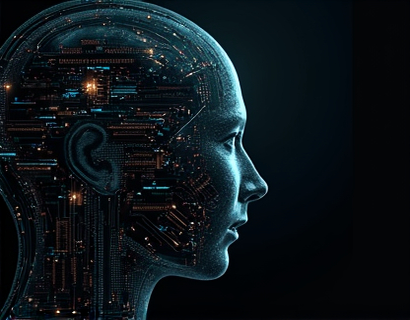Transforming Digital Interactions: The Synergy of Crypto and AI
The intersection of cryptocurrency and artificial intelligence (AI) is revolutionizing the digital landscape, offering unprecedented opportunities for enhanced user engagement and innovative solutions. This convergence is not just a technological curiosity but a transformative force that is reshaping how we interact with digital platforms and services. As we delve into the latest advancements, it becomes clear that the integration of crypto and AI is paving the way for a more secure, efficient, and personalized digital experience.
Enhanced Security through Cryptographic Techniques
One of the most significant contributions of cryptocurrency to digital interactions is the enhancement of security protocols. Cryptographic techniques, such as blockchain, provide a decentralized and immutable ledger that ensures data integrity and transparency. This is particularly crucial in an era where data breaches and cyber threats are increasingly common. By leveraging blockchain, platforms can offer robust security measures that protect user data and transactions, fostering trust and confidence among users.
Moreover, the use of smart contracts on blockchain networks automates and enforces contractual obligations without the need for intermediaries. This not only reduces the risk of fraud but also streamlines processes, making them faster and more reliable. For digital interactions, this means a more secure and seamless experience, whether it's conducting financial transactions, sharing sensitive information, or engaging in peer-to-peer communications.
Personalization through AI-Driven Insights
AI plays a pivotal role in personalizing digital experiences, tailoring content and services to individual preferences and behaviors. By analyzing vast amounts of data, AI algorithms can identify patterns and predict user needs, enabling platforms to deliver highly customized interactions. This level of personalization is transformative, as it enhances user engagement and satisfaction, leading to higher retention rates and increased loyalty.
For instance, AI-powered recommendation systems can suggest products, articles, or services based on a user's past interactions and preferences. In the context of cryptocurrency, AI can analyze market trends and user behavior to provide insights and recommendations for investment decisions. This synergy between crypto and AI not only empowers users with valuable information but also creates more intuitive and user-friendly interfaces.
Decentralized Identity Management
Decentralized identity management is another area where the combination of crypto and AI is making a significant impact. Traditional identity verification processes are often centralized, vulnerable to hacking, and prone to misuse. Blockchain-based identity solutions offer a decentralized approach, giving users control over their personal data and reducing the risk of identity theft.
AI enhances this process by enabling secure and efficient verification methods. For example, biometric data can be stored on a blockchain, and AI algorithms can verify the authenticity of this data in real-time. This ensures that only authorized users access their information, maintaining privacy and security. The result is a more trustworthy and user-centric identity management system that aligns with the principles of decentralization and user empowerment.
Fraud Detection and Prevention
Fraud remains a persistent challenge in the digital world, affecting various sectors from finance to e-commerce. The integration of AI in cryptocurrency transactions can significantly mitigate this risk. Machine learning algorithms can analyze transaction patterns and detect anomalies that indicate fraudulent activity. By continuously learning from new data, these systems become more accurate over time, reducing false positives and improving overall security.
AI-driven fraud detection is not limited to financial transactions. It can also be applied to prevent identity fraud, phishing attacks, and other cyber threats. For digital platforms, this means a safer environment for users to interact and transact, which is essential for building and maintaining trust. The proactive approach to fraud prevention enhances the reliability and credibility of crypto-enabled services, making them more attractive to a broader audience.
Enhancing User Experience through Chatbots and Virtual Assistants
Chatbots and virtual assistants powered by AI are revolutionizing user interactions on digital platforms. These AI-driven tools can provide instant support, answer queries, and guide users through various processes, all while maintaining a natural and conversational tone. In the context of cryptocurrency, chatbots can assist users with transactions, account management, and investment advice, making the experience more accessible and user-friendly.
Moreover, the integration of natural language processing (NLP) allows these AI assistants to understand and respond to complex queries, further enhancing the user experience. For instance, a user can ask for the current price of a specific cryptocurrency or get a summary of their portfolio, and the AI assistant will provide accurate and timely information. This level of convenience and efficiency not only improves user satisfaction but also encourages more frequent and deeper engagement with the platform.
Tokenization of Assets and Services
Tokenization, facilitated by blockchain technology, is transforming the way assets and services are represented and traded in the digital realm. By converting tangible and intangible assets into digital tokens, platforms can offer fractional ownership, increased liquidity, and greater accessibility. This is particularly relevant for the crypto space, where tokens can represent everything from real estate and art to utility services and loyalty points.
AI plays a crucial role in optimizing tokenization processes. Machine learning algorithms can analyze market data, user behavior, and asset performance to determine optimal token issuance strategies. This ensures that tokens are priced fairly and attract the right investors. Additionally, AI can facilitate smart contracts that automate the distribution and management of tokens, reducing administrative costs and enhancing transparency.
The tokenization of assets and services not only opens up new revenue streams but also democratizes access to investment opportunities. Users can now participate in the economy with smaller investments, making it more inclusive and dynamic. This synergy between crypto and AI is redefining the financial landscape, offering innovative solutions that cater to a diverse range of users.
Predictive Analytics for Better Decision-Making
Predictive analytics, powered by AI, is a game-changer for both businesses and users in the crypto ecosystem. By analyzing historical data and real-time trends, AI algorithms can forecast market movements, user behavior, and other key metrics. This foresight enables more informed decision-making, whether it's investing in cryptocurrencies, launching new services, or optimizing marketing strategies.
For businesses, predictive analytics can identify emerging trends and consumer preferences, allowing them to adapt quickly and stay ahead of the competition. For users, this means a more tailored and responsive digital experience, with services and content that align with their interests and needs. The ability to anticipate and react to changes in the digital environment is a significant advantage, fostering growth and innovation in the tech sector.
Interoperability and Cross-Platform Integration
Interoperability is a critical aspect of the crypto and AI convergence, enabling seamless interactions across different platforms and systems. Blockchain technology, with its standardized protocols, facilitates interoperability by allowing different blockchain networks to communicate and exchange data. AI enhances this process by providing the intelligence needed to manage and optimize these interactions.
For digital platforms, interoperability means users can seamlessly transition between services, carrying their data and assets with them. This not only improves user convenience but also fosters a more connected and integrated digital ecosystem. AI-driven solutions can manage complex cross-platform transactions, ensuring smooth and secure interactions. The result is a more cohesive and user-centric digital experience, where boundaries between different services blur, and users enjoy a unified and streamlined experience.
Conclusion
The convergence of cryptocurrency and AI is ushering in a new era of digital interactions, characterized by enhanced security, personalized experiences, and innovative solutions. As these technologies continue to evolve, the potential for transformation is immense. For tech enthusiasts and professionals, understanding and embracing this synergy is essential for staying ahead in the rapidly changing digital landscape. The future is bright, with endless possibilities for growth and engagement at the intersection of crypto and AI.










































